Editorial
What a difference a few weeks can make. I'd expected June was going to be hectic and challenging as I relocated a large equipment room and redesigned the network on the fly. But the spin-off spun-out, so a fire-sale replaced the move and I'll be taking up a research scientist position with the University of Queensland for the next little while. There are always silver linings and painful as the last few weeks have been, at least I won't now have to buy a new suit and modern ties. And I've gained some shop time which I've spent turning stainless steel into Cirrus valves. The score so far, four good ones, another four usable ones, and four rejects. So I could call the task complete, though I suspect I'll be making another four in the vain, perpetual quest for perfection.
It's been a while since I climbed up on the Spam soap-box, so here we go (again). The volume of junk mail I get has become staggering, even with all sorts of filters and things. The danger with filters is they employ rules that may reject a valid enquiry by a reader who has found an isolated page from a Google search, but has not seen the Model Engine News oeuvre. They may begin with a respectful "Dear Sir or Madam". This gets a few points from the SPAMASSASSIN, and it does not take too many more innocent phrases before the mail is vectored to the box I never read--or only scan the heading of. So I either read all the SPAMASSASSIN tagged mail--which rather defeats the purpose of the thing--or relax the rules and read the mail anyway. Or keep the filters, don't read the mail, and risk upsetting a reader who expected a response!
I try to respond to readers' requests within 24 hours. Some requests I will ignore: "I want to build an engine, so send me all your plans immediately." (I've paraphrased, but that one has arrived more than once). Many emails are requests for me to identify or value an engine that the sender wants to put on eBay. Frequently these arrive without a photo, making the task even more error-prone. I'm reluctant to do this, but I will respond (perhaps with the aid of a Blue Book price range). So, to all readers, if you've emailed asking for less than all my assets and bank account details, but not received a response, your mail has probably been declared "Spam" and I've not read it. I encourage you to keep your cool, understand my side of the problem, and try again (Ron climbs down reluctantly from the soap-box, having not once mentioned Bill Gates, Microsoft, and the mythical Cure For Spam  ).
).
 This month we have the most words I've ever written for an "Engine of the Month" review. I'd thought the review would be embarrassingly short, but the more I dug, the more emerged. In the end, a lot of little details about the subject had been uncovered, together with a connection between ETA and New Zealand that I suspect has not been recorded anywhere before! All this can now be inflicted upon you. The series on the "Ideal Beginners' Engine Project" has got another subject, although you'll find I don't consider it all that suitable. And we've got the book review promised last month, a tech tip, plus the usual news and updates. Enjoy...
This month we have the most words I've ever written for an "Engine of the Month" review. I'd thought the review would be embarrassingly short, but the more I dug, the more emerged. In the end, a lot of little details about the subject had been uncovered, together with a connection between ETA and New Zealand that I suspect has not been recorded anywhere before! All this can now be inflicted upon you. The series on the "Ideal Beginners' Engine Project" has got another subject, although you'll find I don't consider it all that suitable. And we've got the book review promised last month, a tech tip, plus the usual news and updates. Enjoy...
ECJ Web Site Operational
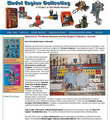
Last month, I mentioned that The Engine Collectors' Journal, the longest running publication dedicated to model engines in the history of model engines, was on the verge of launching a web site. Editor Tim Dannels now figures it's as ready for public consumption as it's likely to get, so click on the thumb-nail and book-mark the page for future reference. A link has also been placed in the MEN Links page.
The Gordon Alpha
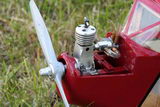
This cute little 0.5cc diesel was designed by Richard Gordon, the same guy who designed the sub-miniature Nano diesel. For a number of reasons, I would not class this as a "Beginner's Project", so why have I added it to the page dedicated to the analysis of designs for beginners? Click the pic to find out.
ET, Phone Home!
Alternately, would Wayne Fellows, resident of Melbourne Australia, please contact Roger Schroeder. Or even someone who knows Wayne, tell him to write, 'phone, or email Roger. We know Wayne is an engine builder because he's ordered plans from Roger and paid for them, but the shipment has been returned with "Not at this address" all over it. Roger has lost the email address he had and is anxious to complete the transaction. Yes, I know this is not exactly a news item, per se, but engine builders should help each other where ever possible, right?
While on the subject, in response to frequent requests, Roger has provided another update to his paper titled Building A Model Airplane Engine that Runs with a wiring schematic for ignition engines.
The Ether-less Diesel
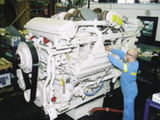
Bet that got your attention! Finding a supplier of the diethyl ether needed to make diesel fuel is getting harder and harder these days. A model compression ignition engine that would run on straight kerosene, or truck type diesel oil would be absolutely perfect. But for-real "injectors" are hard to make at model sizes, and the small volumes of air that we see compressed in a model engine cylinder don't provide as much heat as you'd find in a big Cummins diesel pot to start the atomized fuel burning, so
true model diesels
(as opposed to the compression ignition engines we call "diesels") while not impossible, are very difficult subjects. But there is another way which has been described a couple of times in the literature (as MEN CD owners will know; hint, hint--plug, plug  ). This experiment has been validated by English model engine builder, Malcolm Beak. Click on the Big Cummins Diesel thumbnail to read about it in Page 8 of the Engine Gallery.
). This experiment has been validated by English model engine builder, Malcolm Beak. Click on the Big Cummins Diesel thumbnail to read about it in Page 8 of the Engine Gallery.
Hex2 Revisited

In the May 2006 issue of Model Engine News, mention was made briefly of Yet Another Cox Based Twin called the Hex2 (patent applied for). At that time, I knew nothing more about it than what could be gleaned from the website. Having now had the chance to inspect the plans and exchange a few emails with the designer, Jerry James, I can supply more detail. First, the good news. Internally, this engine is the simplest practical twin I've ever seen. I've no doubt that a builder with very little experience and limited equipment could build it successfully. The bad news, if it can be called that, is the engine probably puts out less power than a single cylinder Cox on which it is based, but you do get approaching twice the noise, plus all the enjoyment of having built your very own running engine. The plans are supplied electronically in pdf format. They are nicely presented and include 12 pages of CAD drawings (actually 6; Jerry provides one set in Imperial measurements, and a duplicate set in metric), plus 15 pages of machining instructions with clear, color photographs.
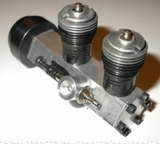 Jerry confesses to having no model airplane engine experience. This may be a good thing as he's done things in the Hex2 that I and other designers with vast experience would never consider (that's the other designers who have the vast experience). I don't want to disclose the unconventional aspects that make the engine so simple except to say there's no radically new concepts here--it's still a rotary shaft inlet valve, alternate firing twin. The single aspect that Jerry is seeking a patent on is not likely to be used by anyone intent on building a practical engine. Curious? You can buy plans from Jerry. Model Engine Builder editor, Mike Rehmus, had intended to feature the Hex2 in the magazine, but that is currently on hold due to the uncertainty regarding supply of the required Cox cylinders.
Jerry confesses to having no model airplane engine experience. This may be a good thing as he's done things in the Hex2 that I and other designers with vast experience would never consider (that's the other designers who have the vast experience). I don't want to disclose the unconventional aspects that make the engine so simple except to say there's no radically new concepts here--it's still a rotary shaft inlet valve, alternate firing twin. The single aspect that Jerry is seeking a patent on is not likely to be used by anyone intent on building a practical engine. Curious? You can buy plans from Jerry. Model Engine Builder editor, Mike Rehmus, had intended to feature the Hex2 in the magazine, but that is currently on hold due to the uncertainty regarding supply of the required Cox cylinders.
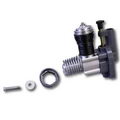 Uncertainty about Cox? Well, it appears that Estes, who acquired Cox some years back, is either closing the model engine production line, or has closed it, depending on which rumor you subscribe to. More rumor says the engine rights and tooling have been offered to a company in China. But right now, according to the Estes web site, you can still order new engines made for the plastic U/C RTF models for just $7. These still represent a reasonable price on Cox cylinders for the Hex2 or your own special Cox-based design. Visit the Cox web site for details.
Uncertainty about Cox? Well, it appears that Estes, who acquired Cox some years back, is either closing the model engine production line, or has closed it, depending on which rumor you subscribe to. More rumor says the engine rights and tooling have been offered to a company in China. But right now, according to the Estes web site, you can still order new engines made for the plastic U/C RTF models for just $7. These still represent a reasonable price on Cox cylinders for the Hex2 or your own special Cox-based design. Visit the Cox web site for details.
25th Century Style

A rakish shark-fin might be a cool accessory to have on your head in the 25th century, but would you want one on the top of your diesel in the first half of the 20th? Apparently the Spanish thought so. We have a new Watzit for you this month. We know a little about it, but would love to hear more from anyone who can provide some background about the manufacturer. Click the cartoon to go to the engine itself, or the next hyperlink if Buck Rogers helmets are of more interest!
New Contact for Hobby Mechanics
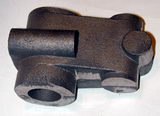
Brisbane based supplier of castings, tooling, and model engineering materials, Hobby Mechanics, has a new email address. Adjust your address books to [email protected]. Back in the December 2005 Model Engine News, we saw the new work-head that Hobby Mechanics Grand Fromage, John Strachan, has had cast for the Quorn Cutter Grinder. The new design can be machined to take any type of commercial collets you like. Hopefully, with more time to spend in the shop now, I'll be able to document the machining of this very useful addition to the Quorn. Naturally, Hobby Mechanics can supply complete casting sets for this and a host of other projects for you to carefully store under the bench, awaiting that blissful, rainy day.
New Books and Magazines This Month

Late last month, Model Engine News received a 4th edition copy of Frank Anderson's "Blue Book". As it arrived only hours before the monthly issue was to be pushed to the web, there was no time to do more than note its arrival and promise more. Well, in the intervening four weeks, I've not only had time to look at it in detail, but also to try it out. And how, you may ask, do you try out a book? Well, paraphrasing Douglas Adams, in order to preserve some sense of dramatic tension, I'll return to that in a moment. First...
There are lots of things you should be taught in school, but aren't. Add the origin of the "Blue Book" concept to your list. I'd thought it was a traditional and sometimes secret book giving used car prices for all makes and models. But some quick web research shows Blue Books for legal citations, grammar and punctuation, guitars, Irish country houses and manors, most states of the USA, etc, etc, not to mention Project Blue Book the original investigation into Unidentified Flying Objects! To this list, you can add Frank and Vicki Anderson's Blue Book that provides a pricing guide for American Model Engines: Anderson's Blue Book: American Model Airplane Engines 1911-2005, 4th Edition, by Frank and Vicki Anderson. Price US$43.95 plus shipping and handling from the author. To order, 'phone +1 (321) 984-0103, or email [email protected]. You can also order on-line using PayPal from http://www.andersonsbluebook.com. And to add fuel to the Great Interconnectness Of Everything theory, Frank's dentist, ever since he became a dentist, is fellow Canadian Dave Sugden!
The Blue Book is a price guide to American model engines. In 110 black and white, double sided pages, it lists 1,518 engines. These are organized alphabetically by manufacturer. For each maker, models are listed by year. Each entry gives the name, displacement, a short description to assist differentiating it from other models, plus a pricing guide and a unique Anderson reference number--which is why I know the book contains 1,518 engine  . Actually, there are more engines listed than this as extra sections in the rear show the Quadra "giant" engines and some short production run "specialties", like Paul Knapp's magnificent scale radials and rotaries, the OTC .19 miniature Brown replica, etc. The book does not contain "1/2A" engines (ie, engines up to 0.09 cuin displacement). Frank hopes to produce a separate book for these, perhaps this year.
. Actually, there are more engines listed than this as extra sections in the rear show the Quadra "giant" engines and some short production run "specialties", like Paul Knapp's magnificent scale radials and rotaries, the OTC .19 miniature Brown replica, etc. The book does not contain "1/2A" engines (ie, engines up to 0.09 cuin displacement). Frank hopes to produce a separate book for these, perhaps this year.
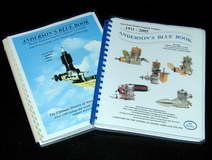 The problem with the "Blue Book" concept lies in the time-volatility of prices. Like used cars, prices of recent models initially fall (mostly), but after a time, something you couldn't give away suddenly acquires value as a collectable. From then on, the only way is up. This requires periodic re-issue of the Blue Books and Frank and Vickie deserve praise for tracking prices paid, updating their databases, and issuing revised editions. I have a copy of the first edition dated 1996 (second printing 1997). The 4th edition appeared in 2005, so new editions have been appearing roughly on a two year cycle. As the pricing data can only ever be a guide to buyers and sellers, this is adequate. Frank lists two prices. One taken from the MECA Swap Sheets, and another taken by observing hammer prices on eBay. It's worth mentioning that the eBay prices are generally double the MECA prices, or higher!
The problem with the "Blue Book" concept lies in the time-volatility of prices. Like used cars, prices of recent models initially fall (mostly), but after a time, something you couldn't give away suddenly acquires value as a collectable. From then on, the only way is up. This requires periodic re-issue of the Blue Books and Frank and Vickie deserve praise for tracking prices paid, updating their databases, and issuing revised editions. I have a copy of the first edition dated 1996 (second printing 1997). The 4th edition appeared in 2005, so new editions have been appearing roughly on a two year cycle. As the pricing data can only ever be a guide to buyers and sellers, this is adequate. Frank lists two prices. One taken from the MECA Swap Sheets, and another taken by observing hammer prices on eBay. It's worth mentioning that the eBay prices are generally double the MECA prices, or higher!
A question you may be asking is which book is better, this one, or Tim Dannel's American Model Engine Encyclopaedia. That depends. Ideally, a serious collector should have both. Tim's book does not attempt to value an engine, and Frank's provides no history beyond the year, so I see them as complimentary.
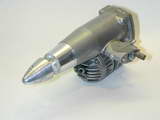 At the start of this review, I mentioned that I'd "used" the 4th edition during the past month. An engine I've lusted after for some time appeared on eBay during June: the "in-line piston" Aero 35. Using the Blue Book, I managed to place a winning bid for the engine that came within 10% of the price ranges quoted. Still requires a bit of luck, but it obviously got me in the ball park. And expect a review of the Aero in the months to come...
At the start of this review, I mentioned that I'd "used" the 4th edition during the past month. An engine I've lusted after for some time appeared on eBay during June: the "in-line piston" Aero 35. Using the Blue Book, I managed to place a winning bid for the engine that came within 10% of the price ranges quoted. Still requires a bit of luck, but it obviously got me in the ball park. And expect a review of the Aero in the months to come...
Engine Of The Month: ETA "5"
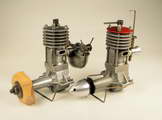
Having discussed Eta 29 spray-bar threads in recent months, it seemed like a good time to look at Eta's first engine. This was a 5cc side-port diesel from 1947 which Peter Fisher named "...the first quality English 5cc diesel...", not that there was a lot of competition in the English 5cc diesel market of the time. Initially, I thought this would be a very short review, but as I dug into the Mountain of Magazines, curious model designations surfaced which have resulted in a rather lengthy stream of wild conjecture that you can probably take with the proverbial grain of sodium chloride. Regardless, if you've ever looked at a picture of one of these and wondered what all those little levers at the back were for, visit the Eta "5" page and find out.
Tech Tip of the Month
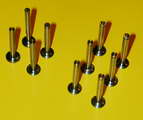
Model Engineering will often require you to create more swarf than part by turning away most of a length of stock to some tiny diameter that is a fraction of the original. As the diameter required becomes small, the danger of producing a taper increases due to flexing of the stock from the cutting forces involved. Whether you are making high precision poppet valves, or just some widget with a thin stem and a big head, this month's tip examines a technique that can help you avoid the dreaded, unintentional taper.
Odds and Sods
Other little updates and corrections have been made all over the site in the past month. While composing the Eta "5" page, I discovered an error in the Giant Engine Review Index where one of the "5" review entries had it classified as a glow! This has, needless to say, been corrected.
Les Stone also confessed to having made a Hinds Twin after contracting a savage bout of twin-itus. This has been added to his Engine Gallery page.
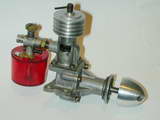 Even the Watzit addition this month caused a ripple. As you have, or will read, it's crankcase bears an uncanny similarity to that of the early ED side-port diesels. When I went to create a link to a photo of one of those to show the resemblance, I discovered (shock horror) that the Engine Finder did not have entries for the historic ED "Penny-slot" and "Competition Special"! This too has been corrected. They have also gone on the to-do list for Engine of the Month archaeology treatment in the near future.
Even the Watzit addition this month caused a ripple. As you have, or will read, it's crankcase bears an uncanny similarity to that of the early ED side-port diesels. When I went to create a link to a photo of one of those to show the resemblance, I discovered (shock horror) that the Engine Finder did not have entries for the historic ED "Penny-slot" and "Competition Special"! This too has been corrected. They have also gone on the to-do list for Engine of the Month archaeology treatment in the near future.
Lastly, One of the jobs that has been in the queue since January has been to assemble the material I've been sent on Gig Eifflaender, designer of the PAW range of engines who left us last December, as announced in the January 2006 issue. Gig's tributes obviously need to be linked into the main menu under "People", but is he a contemporary, or a pioneer? Difficult question. I asked fellow Motor Boy, David Owen. Dave knew Gig, having been a distributor of PAW engines for nearly 30 years. He felt that Gig was both a pioneer and a contemporary in the sense that he produced diesel engines of his own unique design not that long after World War II, and was still in production in 2006. I've gone with pioneer.
 ECJ Web Site Operational
ECJ Web Site Operational
 The Gordon Alpha
The Gordon Alpha
 ET, Phone Home!
ET, Phone Home!
 Hex2 Revisited
Hex2 Revisited
 The Ether-less Diesel
The Ether-less Diesel
 25th Century Style
25th Century Style
 New Contact for Hobby Mechanics
New Contact for Hobby Mechanics
 Odds and Sods
Odds and Sods
 Editorial
Editorial
 New Books and Magazines This Month
New Books and Magazines This Month
 Engine Of The Month: Eta "5"
Engine Of The Month: Eta "5"
 Tech Tip of the Month
Tech Tip of the Month
 Standard Stuff
Standard Stuff
 ).
).
 This month we have the most words I've ever written for an "Engine of the Month" review. I'd thought the review would be embarrassingly short, but the more I dug, the more emerged. In the end, a lot of little details about the subject had been uncovered, together with a connection between ETA and New Zealand that I suspect has not been recorded anywhere before! All this can now be inflicted upon you. The series on the "Ideal Beginners' Engine Project" has got another subject, although you'll find I don't consider it all that suitable. And we've got the book review promised last month, a tech tip, plus the usual news and updates. Enjoy...
This month we have the most words I've ever written for an "Engine of the Month" review. I'd thought the review would be embarrassingly short, but the more I dug, the more emerged. In the end, a lot of little details about the subject had been uncovered, together with a connection between ETA and New Zealand that I suspect has not been recorded anywhere before! All this can now be inflicted upon you. The series on the "Ideal Beginners' Engine Project" has got another subject, although you'll find I don't consider it all that suitable. And we've got the book review promised last month, a tech tip, plus the usual news and updates. Enjoy...













